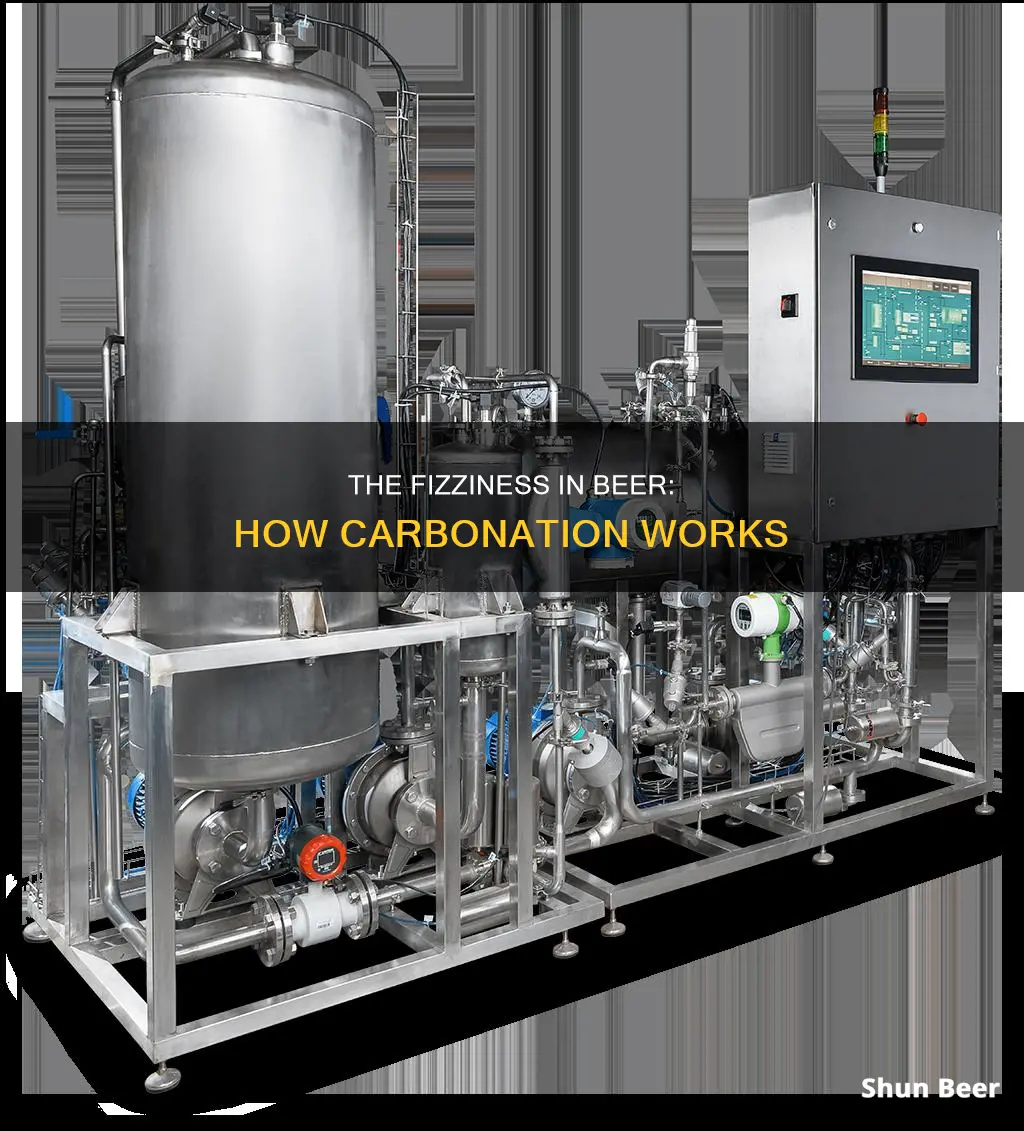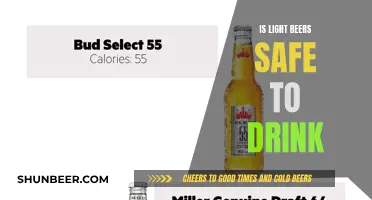
Carbonation is an essential part of the beer-making process, giving beer its distinctive fizz and bubbles. In simple terms, carbonation is the process of adding carbon dioxide gas to a liquid, in this case, beer. The amount of carbonation in a beer depends on the style and format, with most ales containing around 4.8g/L of carbon dioxide, and lagers or wheat beers generally having a higher amount. Carbonation occurs naturally during the fermentation process as yeast produces carbon dioxide alongside alcohol when it consumes sugar. However, additional carbonation can be added through natural or forced carbonation methods, where carbon dioxide is sealed in a container with the beer under pressure, resulting in the beer absorbing the gas and becoming carbonated.
| Characteristics | Values |
|---|---|
| What is carbonation? | The process of adding carbon dioxide to beer |
| Why is carbonation important? | It gives beer its distinct refreshing aspect and contributes to its mouthfeel |
| How does it work? | Carbonation occurs naturally in beer as yeast produces carbon dioxide along with alcohol when they eat sugar. The amount of carbonation depends on the amount of sugar added. |
| Natural carbonation | Results from the fermentation process. The brewer seals the beer in a container when it is almost complete. |
| Forced carbonation | Carbon dioxide is pumped into a sealed container with the beer. |
| Maintaining carbonation | Beer must be fully sealed with a tight bottle cap to maintain carbonation. Beer should be drunk within a few hours of opening. |
| Storing beer | Beers should be packaged in dark bottles and stored in a cool, dark place away from sunlight. |
What You'll Learn

Carbonation occurs naturally during the fermentation process
Carbonation is the process of adding carbon dioxide gas to a liquid. In the context of beer, carbonation occurs naturally during the fermentation process.
Fermentation occurs when yeast consumes sugar, producing alcohol and carbon dioxide as by-products. During fermentation, most of the carbon dioxide escapes, but brewers can control the carbonation level by sealing the beer in a container, such as a bottle or a keg, before the process is complete. This prevents the carbon dioxide from escaping, allowing it to dissolve into the beer and creating those distinctive bubbles.
The amount of carbonation in beer depends on several factors, including the type of beer and the desired level of fizziness. For example, ales typically have around 4.8 grams of carbon dioxide per litre, while lagers and wheat beers tend to have a higher carbonation level.
Brewers can also control the carbonation level by adjusting the amount of sugar added to the beer before bottling or by using different carbonation methods, such as forced carbonation or natural carbonation in bottles or casks.
Natural carbonation in bottles involves allowing the beer to ferment completely, adding a small amount of sugar, and then sealing the bottles. The yeast then acts on the sugar, producing carbon dioxide that is absorbed by the beer, resulting in a fizzy beverage.
Beer Die: A Fun Guide to the Game and its Rules
You may want to see also

Brewers can force carbonation by pumping CO2 into beer under pressure
Carbonation is the process of adding carbon dioxide gas to a liquid. In the case of beer, carbonation gives the beverage its distinctive fizz and contributes to its refreshing mouthfeel. While natural carbonation occurs during the fermentation process, brewers can also force carbonation by pumping CO2 into beer under pressure.
Forced carbonation is a common method used for kegs. It involves pumping carbon dioxide into a sealed container with the beer, allowing the gas to be absorbed into the liquid. The process is typically done after the beer has been refrigerated, with the cold temperature aiding in the dissolution of CO2 into the beer.
The amount of carbonation desired will dictate the level of carbon dioxide added to the beer. Most ales have around 4.8g/L (or 2.7 grams per pint) of carbon dioxide, while lagers and wheat beers generally have a higher level. The specific gravity of the beer, or its density relative to water, can also impact the amount of carbonation achieved.
To achieve forced carbonation, brewers may use a "carbonation stone," a small ceramic cylinder that diffuses the gas into the beer through tiny pores, increasing the contact efficiency between the gas and the liquid. Alternatively, brewers can apply pressure to the top of the liquid, allowing the beer to absorb CO2 over a few days.
Forced carbonation is a faster and more controlled method of carbonating beer compared to natural carbonation. By manipulating temperature and pressure, brewers can ensure that the desired level of carbonation is achieved before packaging and distribution.
Brita Water Filter: The Ultimate Beer Upgrade?
You may want to see also

Beer must be sealed to maintain carbonation
To keep the carbonation, the beer must be sealed in a container under pressure. This can be done through natural or forced carbonation. In both methods, the beer is sealed in a container, such as a bottle or a keg, with carbon dioxide. The seal ensures that the carbon dioxide cannot escape until the beer is opened.
In natural carbonation, the carbonation results from the fermentation process. Yeast produces carbon dioxide as it digests the sugar in the wort. The brewer seals the beer in a container when fermentation is almost complete, allowing the carbon dioxide to be absorbed into the beer. This method is often used for casks and bottles.
Forced carbonation involves pumping carbon dioxide into a sealed container with the beer. This method is commonly used for kegs and is typically done after the beer has been refrigerated. The carbon dioxide is absorbed into the beer, fully carbonating it within a few days.
To maintain carbonation, it is essential to ensure a tight seal on the beer container. For bottled beer, this means using a tight bottle cap. Once opened, the beer should be consumed within a few hours, as the carbonation will be lost, and the taste will be affected. Most beers with low alcohol content can be stored unopened for about six months, while beers with higher alcohol content can be aged for a few years to improve their flavour.
A Beer Lover's Guide to Mohegan Sun Fest
You may want to see also

The colder the beer, the more CO2 it can hold
The level of carbonation in beer is influenced by two factors: the pressure of CO2 forced into it and the temperature of the beer. Cold liquids will absorb and hold CO2 more efficiently than warmer liquids. This is due to Henry's Law, which states that higher pressure and lower temperatures result in more effective gas absorption by liquids.
In simple terms, carbonation is the carbon dioxide gas dissolved in a liquid. To keep the carbon dioxide gas in the liquid, pressure is required. In the case of beer, this pressure is provided by a sealed bottle cap or tab. When the pressure is released by opening the bottle or tab, the carbon dioxide rises to escape in the form of bubbles or carbonation.
The carbonation level of beer is determined by the temperature and pressure applied within the keg. The colder the beer, the more CO2 it can absorb and hold. This is why a warm can of soda tends to fizz more than a cold one from the fridge; the warmer liquid cannot contain as much gas.
Brewers take advantage of this principle, utilising higher pressure and lower temperatures to achieve more efficient absorption of CO2 into the beer. By carbonating beer at colder temperatures, brewers can ensure that the beer retains its carbonation and delivers the desired level of fizziness when opened and served.
Additionally, the desired level of carbonation can vary depending on the style of beer. For example, a cask-conditioned real ale typically has lower carbonation levels, while a German weizen will have higher carbonation levels and is served colder. Ultimately, the temperature plays a crucial role in determining how much CO2 can be dissolved in the beer, influencing the beer's mouthfeel, aroma, and flavour.
Beer Science: Brewing Chemistry and History Podcast
You may want to see also

Bottle conditioning is a natural carbonation method that can also improve flavour
Carbonation is the process of adding carbon dioxide to a liquid. In the context of beer, carbonation gives beer its distinct refreshing fizz and contributes to its mouthfeel. Beer can be carbonated in two ways: natural and forced carbonation.
Bottle conditioning results in a thin film of dead yeast cells collected at the bottom of the bottle. These are harmless and, in some beer styles, a key component of the beer's profile. Beers that go through bottle conditioning continue to develop and grow in complexity over time thanks to the secondary fermentation. This means that the longer a beer is allowed to rest during in-bottle fermentation, the better it will be. In theory, bottle conditioning can improve the flavour of beer by allowing it to mature and bring out a deeper character in the flavours.
To successfully bottle condition beer, four key components must be considered: yeast, sugar, temperature, and time. Firstly, there needs to be enough viable yeast to convert sugar into CO2, which creates carbonation. Secondly, there needs to be enough fermentable sugar for the yeast to transform into CO2. The temperature should be between 68-80°F, which is the general range for bottle conditioning. Lastly, bottle conditioning typically takes 2-4 weeks to complete.
Energy and Alcohol: Do Beer and Red Bull Work?
You may want to see also
Frequently asked questions
Carbonation is the process of adding carbon dioxide gas to a liquid. In the case of beer, carbonation gives it a distinct refreshing aspect and contributes to its mouthfeel.
Carbonation in beer can be achieved through natural or forced carbonation. Natural carbonation occurs during the fermentation process, where yeast produces carbon dioxide and alcohol by digesting sugar. Forced carbonation involves pumping carbon dioxide into a sealed container with the beer.
Natural carbonation occurs during the fermentation process, where yeast produces carbon dioxide along with alcohol. Forced carbonation is a faster method where carbon dioxide is pumped into a sealed container with the beer under pressure.
The amount of carbon dioxide that can be dissolved in a beer is inversely proportional to the temperature of the beer. Colder beer can hold more carbon dioxide, which is why carbonation levels are higher in chilled beers.







